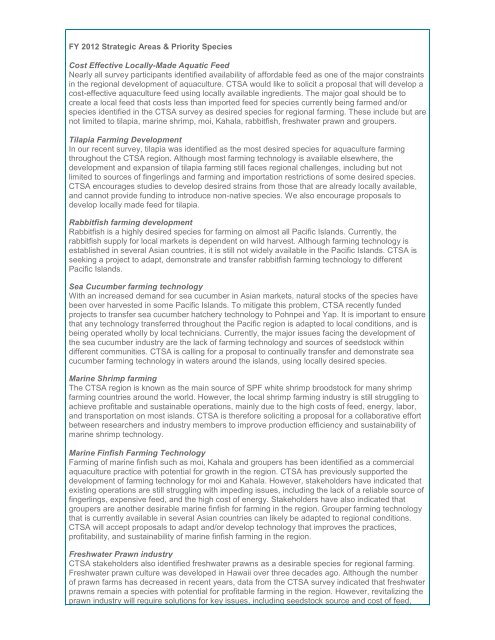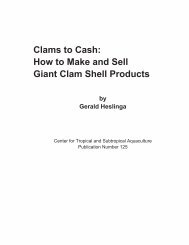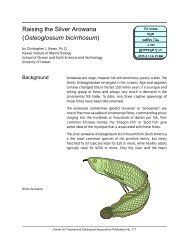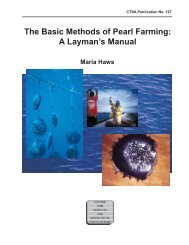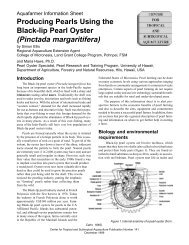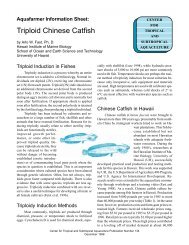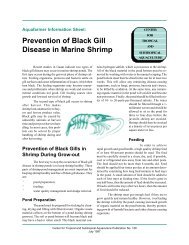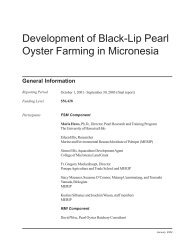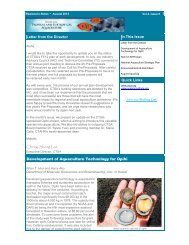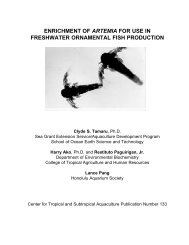Letter from the Director Cheng-Sheng Lee In This Issue ... - CTSA
Letter from the Director Cheng-Sheng Lee In This Issue ... - CTSA
Letter from the Director Cheng-Sheng Lee In This Issue ... - CTSA
- No tags were found...
Create successful ePaper yourself
Turn your PDF publications into a flip-book with our unique Google optimized e-Paper software.
FY 2012 Strategic Areas & Priority SpeciesCost Effective Locally-Made Aquatic FeedNearly all survey participants identified availability of affordable feed as one of <strong>the</strong> major constraintsin <strong>the</strong> regional development of aquaculture. <strong>CTSA</strong> would like to solicit a proposal that will develop acost-effective aquaculture feed using locally available ingredients. The major goal should be tocreate a local feed that costs less than imported feed for species currently being farmed and/orspecies identified in <strong>the</strong> <strong>CTSA</strong> survey as desired species for regional farming. These include but arenot limited to tilapia, marine shrimp, moi, Kahala, rabbitfish, freshwater prawn and groupers.Tilapia Farming Development<strong>In</strong> our recent survey, tilapia was identified as <strong>the</strong> most desired species for aquaculture farmingthroughout <strong>the</strong> <strong>CTSA</strong> region. Although most farming technology is available elsewhere, <strong>the</strong>development and expansion of tilapia farming still faces regional challenges, including but notlimited to sources of fingerlings and farming and importation restrictions of some desired species.<strong>CTSA</strong> encourages studies to develop desired strains <strong>from</strong> those that are already locally available,and cannot provide funding to introduce non-native species. We also encourage proposals todevelop locally made feed for tilapia.Rabbitfish farming developmentRabbitfish is a highly desired species for farming on almost all Pacific Islands. Currently, <strong>the</strong>rabbitfish supply for local markets is dependent on wild harvest. Although farming technology isestablished in several Asian countries, it is still not widely available in <strong>the</strong> Pacific Islands. <strong>CTSA</strong> isseeking a project to adapt, demonstrate and transfer rabbitfish farming technology to differentPacific Islands.Sea Cucumber farming technologyWith an increased demand for sea cucumber in Asian markets, natural stocks of <strong>the</strong> species havebeen over harvested in some Pacific Islands. To mitigate this problem, <strong>CTSA</strong> recently fundedprojects to transfer sea cucumber hatchery technology to Pohnpei and Yap. It is important to ensurethat any technology transferred throughout <strong>the</strong> Pacific region is adapted to local conditions, and isbeing operated wholly by local technicians. Currently, <strong>the</strong> major issues facing <strong>the</strong> development of<strong>the</strong> sea cucumber industry are <strong>the</strong> lack of farming technology and sources of seedstock withindifferent communities. <strong>CTSA</strong> is calling for a proposal to continually transfer and demonstrate seacucumber farming technology in waters around <strong>the</strong> islands, using locally desired species.Marine Shrimp farmingThe <strong>CTSA</strong> region is known as <strong>the</strong> main source of SPF white shrimp broodstock for many shrimpfarming countries around <strong>the</strong> world. However, <strong>the</strong> local shrimp farming industry is still struggling toachieve profitable and sustainable operations, mainly due to <strong>the</strong> high costs of feed, energy, labor,and transportation on most islands. <strong>CTSA</strong> is <strong>the</strong>refore soliciting a proposal for a collaborative effortbetween researchers and industry members to improve production efficiency and sustainability ofmarine shrimp technology.Marine Finfish Farming TechnologyFarming of marine finfish such as moi, Kahala and groupers has been identified as a commercialaquaculture practice with potential for growth in <strong>the</strong> region. <strong>CTSA</strong> has previously supported <strong>the</strong>development of farming technology for moi and Kahala. However, stakeholders have indicated thatexisting operations are still struggling with impeding issues, including <strong>the</strong> lack of a reliable source offingerlings, expensive feed, and <strong>the</strong> high cost of energy. Stakeholders have also indicated thatgroupers are ano<strong>the</strong>r desirable marine finfish for farming in <strong>the</strong> region. Grouper farming technologythat is currently available in several Asian countries can likely be adapted to regional conditions.<strong>CTSA</strong> will accept proposals to adapt and/or develop technology that improves <strong>the</strong> practices,profitability, and sustainability of marine finfish farming in <strong>the</strong> region.Freshwater Prawn industry<strong>CTSA</strong> stakeholders also identified freshwater prawns as a desirable species for regional farming.Freshwater prawn culture was developed in Hawaii over three decades ago. Although <strong>the</strong> numberof prawn farms has decreased in recent years, data <strong>from</strong> <strong>the</strong> <strong>CTSA</strong> survey indicated that freshwaterprawns remain a species with potential for profitable farming in <strong>the</strong> region. However, revitalizing <strong>the</strong>prawn industry will require solutions for key issues, including seedstock source and cost of feed,


